- Usage: Commercial
- Color: Black
- Width: 24 19/25"
- Height: 27 18/50"
- Depth: 21 73/100"
Pudu 10110000039 CC1 Intelligent Commercial Cleaning Robot, Four-in-1 Versatile Cleaning, 4G, 17000 PA Suction Power, Auto Charging (Black)
- Usage: Commercial
- Color: Black
- Width: 24 19/25"
- Height: 27 18/50"
- Depth: 21 73/100"
PUDU CC1
The PUDU CC1 robot is a versatile cleaning robot designed for small and medium-sized scenarios. It integrates sweeping, scrubbing, (carpet) vacuuming, and dust mopping and features auto-filling/draining and auto-charging functions.
It is suitable to various cleaning scenarios with different materials and hardness, whether hard floors or low pile carpet. Its typical application scenarios include office buildings, departments, hotels, retail store and other indoor scenarios that require a light cleaning. The product improves the overall cleanliness of the environment at lower costs and higher efficiency.
- Stable efficiency and higher quality of cleaning
- Lower recruitment, training and management costs
- Reduce employee injuries and absences
- Easily deal with custodial inspections with digital reports
Four-in-1 Versatile Cleaning
Sweeping, scrubbing, vacuuming, and mopping functions in one. Meet all your cleaning needs with one machine.
Super Suction Power
17000 PA No stain left behind
Fit Corners Perfectly
Efficient ultimate edge cleaning in certain scenes with side brush
Suit Various Floor Types
Suitable for both hard floors and soft carpets
Extendable Steering Handle for Ease of Operation
Extension handle makes it convenient to build cleaning maps and handle unexpected cleaning emergencies
Breakpoint Resume Cleaning
If the power is low but the cleaning task hasn’t been completed, CC1 can remember the cleaning progress and resume the previously unfinished task after being fully charged.
PUDU SLAM
Navigation Solution
Powered by the PUDU SLAM positioning system, CC1 supports both visual SLAM and laser SLAM to perform tasks more efficiently in complex scenarios.
Automatic Water Addition & Drainage
Docking Station + Mobile Water Station: No need for plumbing modifications, Supports automatic charging, water supply and drainage, and detergent addition.
Auto Charging
Charging Station: The robot will automatically return to the charging station when the power is low.
Digital Cleaning
Get real-time notifications and reports for cleaning performance such as the cleaning time and area.
Digitization and visualization of cleaning effects
Collect and summarize the working status of each unit and automatically generate a cleaning report.
Usage Scenarios
- Office Building
- Education
- Retail
- Food & Beverage
- Public Transportation
- Health Care
- Manufacturing
- Hospitality
Product Overview
Cleaning Mode: Sweeping/Mopping/Scrubbing/Vacuuming
Water Tank Capacity
- Clean Water Tank 15L
- Waste Water Tank 15L
Charging Time: < 3h
- Battery Life
- Scrubbing: 5h
- Sweeping+Vacuuming+Mopping: 5h
- Carpet vacuuming: 4h
- Silent mopping: 9h
Cleaning Operating Noise: < 70dB(A)
Cruise Speed: Max 1.2m/s (Max 3.94ft/s)
Suction: 10000~15000 Pa
Cleaning Efficiency
- 720~1200 ㎡/h
- (7750-12912 ft²/h)
| Feature | Description |
| Model | CCBC01 |
| Operating voltage | DC 23 V–29.2 V |
| Power input | AC 100 V–240 V, 50/60 Hz |
| Power output | 29.2 V,15 A |
| Battery capacity | 50 Ah |
| Charging time | < 3 h |
| Battery life | 3 h–8 h |
| Cleaning capabilities | Scrubbing: 5 h; Sweeping+Vacuuming+Mopping: 5 h |
| Carpet vacuuming: 4 h;Silent mopping: 9 h | |
| Weight | 75 kg (165.35 pounds) |
| Screen size | 10.1-inch LCDscreen |
| Robot dimensions (L×W×H) |
62.9*55.2*69.5 cm (24.76*21.73*27.36 inches) |
| Enclosure material | PC+ABS |
| Navigation method | Integrated lidar and visual SLAM positioning |
| Cruise speed | 0.2–1.2 m/s (0.66–3.94 ft/s) |
| Working noise | < 70 dB |
| Max. climbing angle | 8º |
| Min. Path Clearance | 70 cm (27.56 inches) |
| Min. turning width | 88 cm (34.65 inches) |
| Min. Passing Height Limit | 76 cm (29.92 inches) |
| Max. surmountable height | 20 mm (0.79 inch) |
| Max. surmountable gap | 35 mm (1.38 inches) |
| Cleaning width (with side brush) | 50 cm (19.69 inches) (MAX) |
| Squeggee/Mopping-vacuuming part cleaning width | 63 cm (24.80 inches) |
| Vacuum cleaner nozzle (for short-haired carpet) | 51.5 cm (20.27 inches) |
| Cleaning efficiency | 700–1000 ㎡/h (7534.74–10763.92 ft²/h) |
| Dustbin capacity | 2.5 L |
| Water tank capacity | Solution tank: 15 L |
| Recovery tank:15 L | |
| Operation system | Android |
| Communication | 4G, WIFI, Bluetooth supported, Lora (Optional) |
| Mobile App | Supported |
| Operation mode | Manual/Auto |
| Auto charging &Auto adding /draining water | Supported (inconjunction with docking station) |
| Optional function | Docking station/Charing station |
| Working environment | Temperature: 1℃ to 40℃ (33.8℉ to 104℉); RH:≤ 85% |
| Storage environment | Temperature: -20℃ to 60℃ (-4℉ to 140℉); RH: ≤ 85% |
| Working altitude | < 2000 m (6561.68 ft) |
| Application scope | Terrazzo, marble, tiles, epoxy resin, sandstone, artificial stone, short-pile carpets, etc. |
| IP rating | IPX4 |
Why Choose Pudu?
Pudu Robotics was founded in 2016. Base in Shenzhen, Pudu Robotics is a world-leading tech-focused enterprise dedicated to the design, R&D, production and sales of commercial service robots on a mission to use robots to improve the efficiency of human production and living.
Since its inception, Pudu Robotics has heavily invested in R&D, obtained multiple awards such as Red Dot and applied hundreds of core patents to lead the development of the robotics category and provide high technology products that would appeal to targeted markets. Pudu Robotics has been rapidly growing in recent years to become a “leader” in the global markets with coverage of
over 60 countries worldwide. The robots are widely applied in restaurants, hospitals, schools, office buildings, government halls, subway stations, waiting rooms, etc.
Q&A
1. How do you use CC1’s “Sweeping, Scrubbing, Carpet Vacuuming, and Silent Mopping” function?
- CC1’s standard sweeping mode consists of three components: a side brush, sweeping brushes, and a mopping-vacuuming part. The mopping-vacuuming part is equipped with a dust vacuuming cavity and a mopping-vacuuming part mop.
In this mode, CC1 performs sweeping, dust vacuuming, and dust mopping simultaneously to ensure a thorough cleaning process. - For the standard scrubbing mode, CC1 utilizes scrubbing brushes and a squeegee.
During scrubbing operation, water is distributed onto the scrubbing brushes, which then moistens and cleans the floor surface. The dirt is subsequently vacuumed into the recovery tank by the squeegee.
Thus, the standard scrubbing mode effectively combines scrubbing and dirt vacuuming in a single operation. - To further optimize CC1’s performance on carpets, a specialized carpet vacuum cleaner nozzle has been developed.
In the carpet vacuuming mode, you have the option to enable or disable the sweeping brushes. When the sweeping brushes are disabled, the device operates in vacuum only mode.
In the carpet vacuuming mode, the carpet vacuuming component efficiently vacuums dust and deposits it into the dust box of the recovery tank.
2. Under what circumstances does CC1 automatically activate its auto function to return to the Docking Station (Workstation) to recharge, refill fresh water, and drain waste water?
- CC1 has certain triggers that prompt it to activate its automatic functions. Specifically, if CC1’s battery level drops below 10%, if the fresh water level falls below 5%, or if the recovery tank becomes full, it will automatically start the process of refilling fresh water or draining the wastewater. Additionally, CC1 will estimate the amount of power required to finish its current tasks and recharge itself until it reaches the estimated power level.
3. Can CC1 work automatically without any manual intervention, allowing for a fully automated operation?
- This can be accomplished by using CC1 together with a Docking Station (Workstation) and setting up scheduled tasks for CC1.
4. How often should CC1 be maintained and have its components cleaned? What are the recommended maintenance frequencies for different parts?
- It is recommended to inspect the cleaning robot approximately every 2 days to ensure proper functioning. The brushes, dust box, water filter box, scrubbing squeegee rubber strips, Mopping-vacuuming Part Mop, side brush, and filter cartridge should be replaced roughly every 3 months. However, the actual replacement frequency may vary depending on the specific cleaning conditions and how frequently the robot is used. You can refer to the consumables replacement frequency table for more specific guidelines.
5. How often is the cleaning report uploaded?
- The cleaning report is uploaded immediately after the completion of the cleaning task. If there is no Internet connection available, the report will be uploaded during the next software startup. It is planned to optimize the logic in the new version.
6. Regarding the cleaning report: How is the cleaning area determined? And could you explain the process of calculating electricity and water consumption?
- In the cleaning report, the cleaning area is determined by multiplying the width of the cleaning path by the duration of cleaning. This calculation takes into account a standard width of 500 mm for the cleaning robot. However, any time spent transitioning or pausing during the cleaning process is not included in the calculation.
- For electricity consumption, it is measured as a battery level percentage difference. This means that the change in electricity usage before and after cleaning is calculated and recorded. Water consumption is measured by using a flow meter, which keeps track of the amount of water used during the cleaning process.
- It’s important to note that the cleaning report may be divided into different sections, and the data from each section is added up to provide a comprehensive overview of the cleaning activities.
7. How can I enable the assist mode?
- To activate the assist mode, follow these simple steps:
- On the home screen, tap on the “More” button.
- Look for the assist mode switch.
- Tap on the switch to turn on the assist mode.
8. If the start time of task 2 is reached while task 1 is running, will the machine execute task 2?
- No, it won’t. At that point, task 2 will be considered null and will not be executed.
9. How is the cleaning time calculated?
- The cleaning time is simply calculated by measuring how long it takes to clean the designated cleaning area and path. However, any time spent pausing during the cleaning process is not counted in the calculation.
10. How is the robot’s starting position for a task determined?
- Zigzag cleaning path (referred to as “Arc” in the software interface): The endpoint of the longer side of the outer path of the cleaning area are chosen in a way that maximizes cleaning efficiency.
- Spiral path (referred to as “Loop” in the software interface): The end point of the outermost path is used as the starting position.
11. How does CC1 handle extricate itself from a difficult situation, and what is its maximum reverse distance?
- When CC1 enters a narrow space or encounters an obstacle that blocks its path, it activates an mechanism to extricate itself from a difficult situation. The robot then explores by moving to the left or right, or by reversing until it finds a wider space. Once the robot reaches the wider space, it continues with its task. It is important to note that CC1 has sensors at the back to detect obstacles and avoid them. The maximum distance the robot can reverse continuously is 30 cm.
12. When is task re-planning triggered?
- Task re-planning is triggered when CC1’s path to the target area is completely blocked by obstacles, and the robot is unable to proceed forward even after attempting to extricate itself from the difficult situation. In this situation, the robot will automatically generate a new path to navigate to a different cleaning task area. The default time limit for being stuck is set to 30 seconds.
13. How does the robot resume cleaning from where it left off due to interruption?
- During an Auto-Cleaning task, if the task is paused or canceled manually, or if the robot automatically returns to its return location, Docking Station (Workstation) or Charging Station (Charging piles) if deployed, due to low battery or low water level, the robot will record the position where the task was interrupted. In the next cleaning operation, the robot will navigate to the recorded position and resume cleaning from there.
14. How much water does CC1 use per hour or per square meter?
- If we consider a minimum cleaning efficiency of 700 square meters per hour, the amount of water used per square meter is estimated to be around 10 mL. So, for every hour of cleaning, the robot will use approximately 3000 mL for low water speed cleaning, 4800 mL for medium water speed cleaning, and 7200 mL for high water speed cleaning settings.
15. Why does CC1 wait to go to the Charging Station (Charging pile) until after completing the cleaning task, instead of charging when it reaches 10% battery level?
- When CC1’s battery level drops to 10%, it usually triggers the robot to return to the charging station. However, if the robot is in the last stage, water collection, of the scrubbing task, it will finish water collection before returning to charge. Moreover, in situations like using elevators, passing through gates, being in traffic control zone (AGV), or during the water collection process, the robot will not start charging even if the battery level is below 10%.
- Additionally, if the estimated power consumption for the remaining cleaning tasks is less than 10%, the robot will continue working. However, if the battery level drops below 5%, the robot will be forced to return to the charging station and recharge.
16. CC1 cleaning agent
- The water supply system of CC1 has been tested for acidity and alkalinity (pH6, pH8) using a water circulation validation method.
- The corresponding pH range for the CC1 cleaning solution is pH6-8, with a recommended range of pH6.5-7.5.
- It is crucial to avoid using cleaning solutions that contain limonene, as it can react with plastic components.
- Instead, it is recommended to use a cleaning solution that is either low-foaming or non-foaming. Alternatively, you can add an anti-foaming agent to reduce foam formation.
- One recommended cleaning solution for CC1 is “Diversey”.
17. When cleaning floors in medium soiled environments, what should you pay attention to?
- Use a water filter box.
- Remove the air filter sponge and tightly cover the lid.
- Regularly wash the suction hose to prevent clogs.
- Adjust the suction power to the highest level.
- It is recommended to use mild cleaning agents that are non-acidic and non-alkaline.
18. Excessive Noise from CC1
- Main scenarios: Quiet environments like shopping malls, offices, and office buildings, etc.
- Main causes: The noise level increases due to the high suction power mode and the relatively quiet surroundings.
- Solution: To address the noise issue, it is recommended to adjust the suction and brush speed settings (primary sources of noise). Furthermore, ensure that the cleaning sequence is organized in a manner where the water collection operation during scrubbing is scheduled as the final step. Ideally, this step should take place in an unoccupied area to minimize noise impact.
19. Scrapes and scratches
- Main reasons:
- One of the main causes for scrapes and scratches is the existence of a blind spot in the rear right area of CC1, leading to incidents when making left or right turns.
- The algorithm did not include the cleaning components within the obstacle avoidance range.
- Solution: Implementing virtual walls or no-go zones in areas prone to scrapes and scratches.
20. Floor with residual water
- Main reasons:
- The floor surface has wide gaps.
- There is water left on the scrubbing squeegee rubber strips.
- There is water left on the inner surface of the scrubbing squeegee suction hose.
- Solution:
- Make sure to regularly maintain the robot to prevent clogging in the suction hose, which can stop the proper vacuuming of waster water.
- Ensure that there are no gaps in the floor in the designated water collection area. The robot will perform a back and forth motion to completely vacuum any remaining waste water from the floor in the designated water collection area.
Specifications | |
| Brand | Pudu |
Appearance | |
| Color | Black |
| Color Family | Black |
Dimensions | |
| Width | 24 19/25" |
| Depth | 21 73/100" |
| Height | 27 18/50" |
Style | |
| Usage | Commercial |
| Scrubbing | Yes |
| Vacuuming | Yes |
| Sweeping | Yes |
| Mopping | Yes |
| Brand | Pudu |
|---|---|
|
Appearance |
|
| Color | Black |
| Color Family | Black |
|
Dimensions |
|
| Width | 24 19/25" |
| Depth | 21 73/100" |
| Height | 27 18/50" |
|
Style |
|
| Usage | Commercial |
| Scrubbing | Yes |
| Vacuuming | Yes |
| Sweeping | Yes |
| Mopping | Yes |

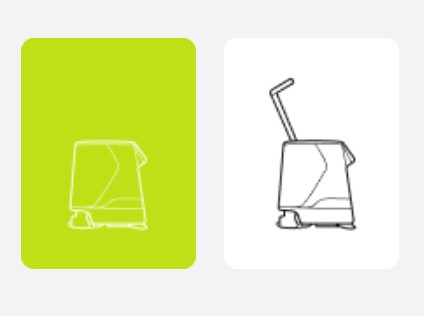
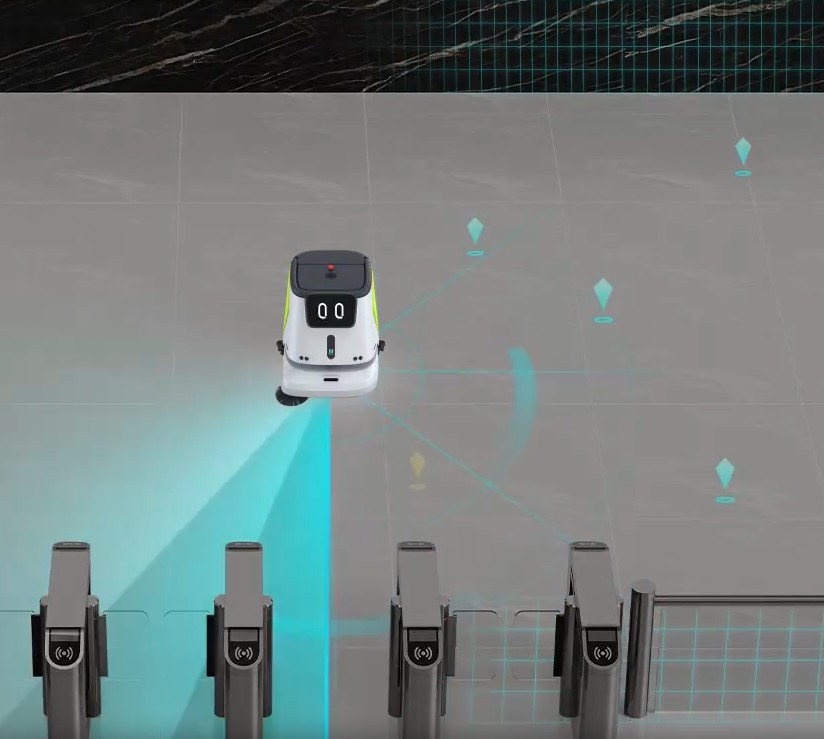
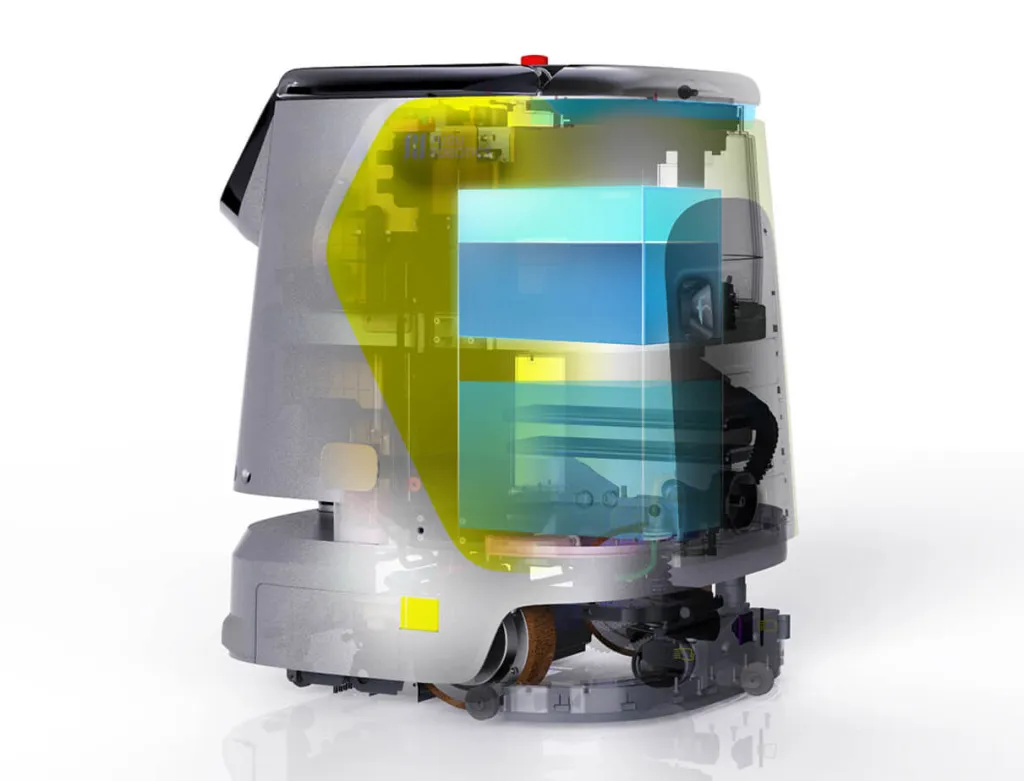
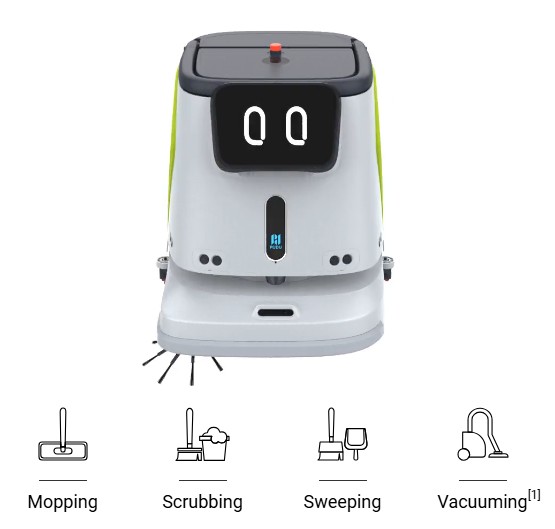

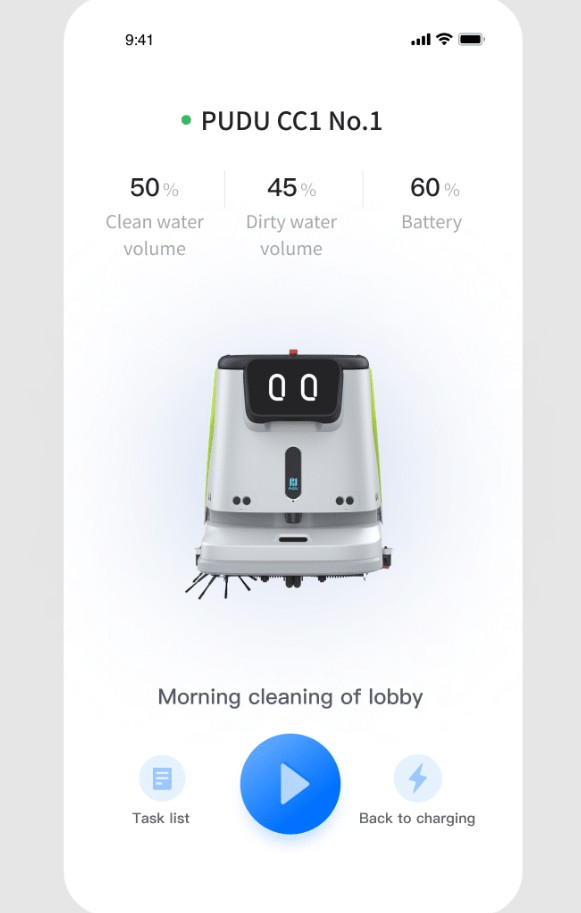
WARNING: This product can expose you to chemicals including arsenic, which is known to the State of California to cause cancer. For more information, go to www.P65Warnings.ca.gov

